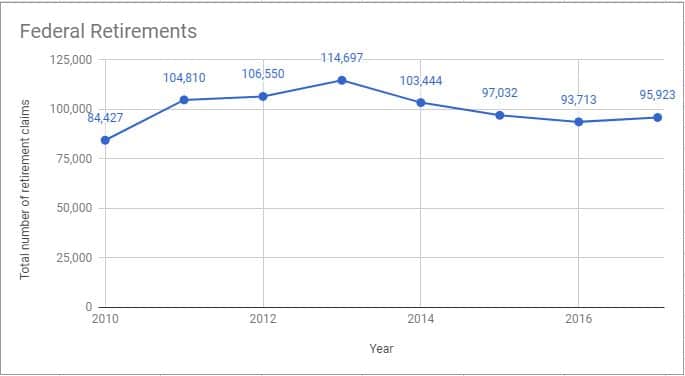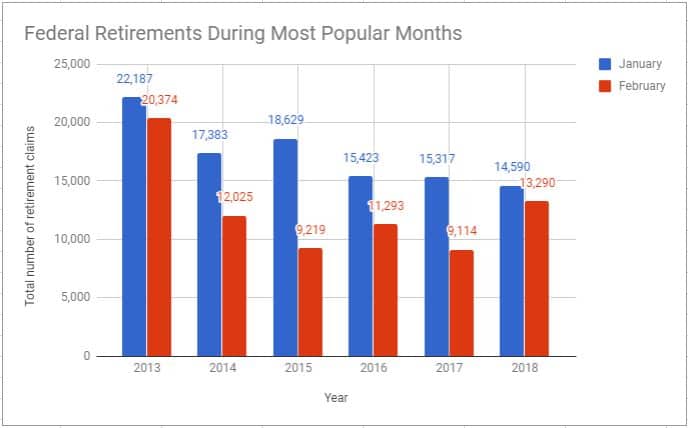
Though more feds retired in 2017 compared to the previous year, it hardly triggered a ‘tsunami’
2017's retirement numbers paled in comparison to those of the mid-years of the Obama administration.
Subscribe to Federal Drive’s daily audio interviews on Apple Podcasts or PodcastOne.
Federal workforce experts have long predicted the dreaded dawn of the “retirement tsunami” — when tens of thousands of newly eligible employees would dart for the door and leave their agencies strapped for institutional knowledge and talent.
And with an uncertain presidential transition, deep proposed budget cuts at certain agencies and calls for significant changes to the federal retirement system, the stars seemed aligned for a mass exodus, some workforce experts said.
After all, 31 percent of the federal workforce was eligible to retire in 2017, according to a 2014 study from the Government Accountability Office. More than 45 percent of federal employees are age 50 or older, according to the most recent data from the Office of Personnel Management.
But 2017 wasn’t the year federal employees left their jobs in droves. In a series of interviews with Federal News Radio, several retirees described a wide variety of reasons for their retirements last year.
To be clear, though some retirees cited budget cuts, low morale and buyouts as a reason for their decision to leave government, many said the decision to retire remained a deeply personal one.
According to the latest data from OPM, more federal employees — 95,923 of them — filed for retirement in 2017 compared to 2016, when 93,713 workers chose to end their government careers.
But far more federal employees retired during each of the five previous years, and 2017’s numbers pale in comparison to the statistics from 2011-2014, when more than 100,000 workers consistently filed for retirement during the middle years of the Obama administration.

By and large, workforce experts say the long-feared federal “retirement tsunami” hasn’t yet hit.
“It hasn’t really manifested itself as we might have thought,” Joe Abusamra, vice president of marketing for Acendre, said January in an interview. “At the same time, the reality is that the federal [workforce] is getting older. They’re not leaving in droves anymore than they were previously, but again, because that age is ticking up, there are more retirements. It’s not the tsunami we’re seeing.”
Federal employees are staying at their jobs longer for three main reasons, Sean Morris, director of Deloitte’s Federal Human Capital Practice, said. Their financial situation, passion for the mission and dedication to their agencies all play a role.
“Those people are just dedicated to the mission,” he said. “They love it. They want to go to work, and they ask themselves if I don’t go to work, what am I going to do? The importance of what they do on a day-to-day basis has continued to be highlighted. There’s a realization that the government struggles with bringing in the next generation at the levels that they need to, and they don’t want to leave a legacy that they’ve spent 30 or 40 years on in the lurch. I believe they are that dedicated.”
The trend, however, may swing in the other direction.
January and February are typically the most popular months for federal employees to retire. While fewer workers filed for retirement in January 2018 compared to the previous years, far more people opted to retire last month compared to February filing totals for the previous four years.
OPM received 13,290 retirement claims in February 2018, according to the latest data the agency posted Monday. About 4,000 more federal employees filed for retirement last month compared to the February 2017.

Why they left
But for the nearly 96,000 federal employees who did retire in 2017, their reasons for doing so ranged far and wide. Though buyouts and priorities from new agency leadership played a role for some in their decisions to retire, many took the leap simply because they were eligible.
Larry Leiby spent nearly 42 years working for the Army. After 41 years and 11 months of service, he couldn’t accrue any more toward his retirement annuity. He spent six additional months working alongside his successor before retiring in January 2017.
“I loved what I did and the only reason I opted to retire was the CSRS retirement accrual provision,” Leiby wrote in an email.
For John Ciszczon, a former letter carrier, his health was the main factor. He walked a 12-mile route every day.
“When I started, I knew which day I was going to retire, and that was my ultimate goal to keep working toward that,” he said.
For many federal employees, finances play the largest role in their decisions to retire.
“It took us 10 years for us to get back to where we were right before the collapse of the economy in 2008,” Morris said. “People’s 401(k)s, whether they were in government or the private sector, took such a massive hit that it’s taken that long for them to get back to where they were a decade before.”
Patricia Jackson, who retired last July after a 23-year career with the Postal Service, said eliminating debt was her number one goal before retiring.
When she achieved that goal, she said she filed for retirement as soon as she could.
Finances also played a big role in the decision for Gary Spegal, a retired lieutenant colonel who spent two decades in active duty and Army reserves before taking a position with the service as a civilian employee.
Spegal received a Voluntary Early Retirement Action/ Voluntary Separation Incentive Payment (VERA/VSIP) notice after the Army announced in 2016 that it would reorganize parts of the U.S. Army Garrison Adelphi Laboratory Center where he worked with a sub-garrison at the Aberdeen Proving Ground in Maryland.
He reviewed his military pension and retirement annuity after he received his VERA/VSIP.
“Adding the two together … my income would be slightly less than when I was working,” Spegal said in an email. “The $40,000 buyout made up a significant portion of the difference. The $25,000 would not have cut it. The $40,000 buyout for the DoD went into effect with [fiscal] 2017, therefore, I pulled the pitch and departed.”
Congress authorized $40,000 buyouts for Defense Department employees, but lawmakers so far haven’t yet extended the higher VERA/VSIP payments to employees at non-defense agencies.
Jim Downing was one of about 400 employees who took a buyout from the Environmental Protection Agency in 2017.
Downing had been preparing and reviewing his annuity and TSP investments in the years leading up to his decision. The buyout, he said, came at the right time.
Latest Retirement News
“I was really getting ready,” he said. “I think I had almost been ready a year ago to retire. [I was] just tired of doing it all. They came along with that buyout and I said, yup, I’m out of here.”
“Had the buyout been more, I might have jumped faster,” he added. “But I certainly thought that the $25,000 was good.”
Downing, who spent his government career doing pesticide regulatory work, said the agency had originally targeted eight out of the 17 people who worked within his former office, the Office of the Scientific Advisor.
“The agency had enough funding to support probably all eight, but the office took a look at it and said, ‘Hey, we’re a small office. We can’t afford to lose more than … four FTE, because when they lost the person, they lost the FTE,” he said.
Only three people, himself included, retired from that EPA office, Downing said.
“It was definitely not business as usual,” Downing said. “The goals and objectives were shifting throughout maybe the whole agency but particularly in certain program areas.”
Marcia Bailey, a former doctoral scientist, ended her 32-year career with the agency because she also saw the work environment change at EPA.
“It was the morale at the agency that was really bad, because in large part of the way Congress was treating us and talking about us,” she said.
It started before President Donald Trump proposed a 31 percent cut to EPA’s budget for fiscal 2018.
“It’s not all about Trump,” Bailey said. “It started maybe three years ago, but it got worse and worse.”
Morale dwindled each year as Congress continued to under-fund the agency, she said.
Downing said he also saw the agency’s priorities shift with the Human Studies Review Board, one of EPA’s federal advisory committees, which he chaired.
“It was a statutorily required board, so they couldn’t do away with it,” he said. “But it sounded like the administration [and] the agency was wanting to do less with it and maybe not support it at the same level that they had in the past. With the regard to the membership selection and stuff like that, it was just going to be different, shall we say.”
But Downing and Bailey carried slightly different attitudes about their decision to leave EPA.
Downing is enjoying his retirement.
“Being able to have the time to do what I want to do when I want to do it … was exactly what I was looking forward to this time last year,” he said of his decision to retire.
But Bailey, who had left a corporate job to join the civil service, said she felt the weight of her decision professionally.
“I haven’t regretted it,” she said. “I’m sad; it left a bad taste in my mouth.”
For Ciszczon, ending his career with the U.S. Postal Service means that he spends less time dealing with management and more time to travel with his family.
“I had just reached the point where I was just ready to worry about myself and enjoy, obviously, the fruits of my own labor,” he said. “I had my health. I had enough money put away, and finally I had time so that I could do these things that I’ve always wanted to do.”
Copyright © 2025 Federal News Network. All rights reserved. This website is not intended for users located within the European Economic Area.
Nicole Ogrysko is a reporter for Federal News Network focusing on the federal workforce and federal pay and benefits.
Follow @nogryskoWFED





